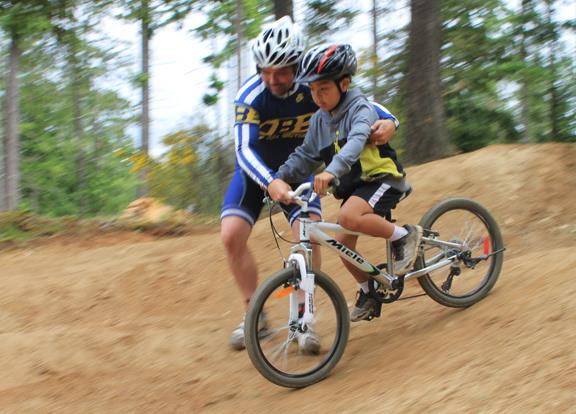Riding on a Lime bike in Reno-Sparks Indian Colony, Nevada. Image: Stacey Montooth
On any given day on Nevada’s Reno-Sparks Indian Colony, Stacey Montooth can spot a neighbor riding by on a bright-green bicycle.It’s still a novelty for Montooth, the community’s spokesperson. Just two months ago, Reno-Sparks Indian Colony quietly became the first known Indigenous territory in the US to get a bikeshare system. Thirty dockless Lime bikes were dropped off in May as part of a larger regional push for bike sharing.Colony member Brendan Abel turned to the Lime bikes when his car recently broke down. “I love the idea of having a bike-sharing program,” he told me in an email. His car’s untimely death made Abel into a multimodal commuter; he uses the bus to make the four-mile trek to work, and uses the bike to exercise and get around town.“Lime has definitely brought back my joy of biking. It’s been a couple years since I rode a bike, and it feels good to be riding again,” he said.Though the project is a pilot for now (it runs to Jan. 31, 2019), Aaron Brukman, Lime’s operations manager in Reno, told me that ridership has been great in the colony. “So far we’ve been able to do right by the community while running a successful business,” he said, noting that Lime pays a small fee per bike to operate on Reno-Sparks Indian Colony.Biking on Indigenous land is still an anomaly, and bike sharing even more so. Most of the 1,200 recognized IIndigenous communities in North America have only got a couple roads in and out—and they’re usually very dangerous for pedestrians and cyclists.On Reno-Sparks Indian Colony, which is home to members of Paiute, Shoshone, and Washoe tribes, there are 1,100 people but just 150 households. Until the bikeshare’s arrival, only a dozen or so die-hards got around the 28-acre community by bike. The tribal council is now looking to extend a riverside bike path onto the reservation.“Keep in mind, it was the federal government’s intention to put American Indian reservations in rural, very remote areas,” Montooth told me in a phone interview. “For some of my family that lives out in the middle of Schurz, Nevada, I don’t know that [bikeshare] would be successful.”“Bicycles are slowly happening,” he said. That’s partly thanks to Glen Sanders, a Pennsylvania teacher and artist who discovered Pine Ridge Reservation 11 years ago, when his car broke down there.After many stalled efforts, Sanders told me he recently delivered on a promise he made all those years ago. Last summer, he brought 129 bikes to Wanblee, the reservation town where Cotner lives. This summer, he’s bringing another 110, as well as bike-fixing materials and volunteer mechanics to teach kids how to do repairs. Cotner said he intends to distribute some of the new bikes to neighboring communities.In Wanblee, Cotner said the bikes are being used for community bike rides. He drew parallels between the community rides and memorial horseback rides, noting, “Every person who got a bike last year has lost a family member since.”Realistically, recreational and short-haul biking may not be enough to stave off or cure chronic illness—but the social element and connection to land that biking brings to Indigenous communities can also be a powerful force.In British Columbia, a program called the Aboriginal Youth Mountain Biking Program is helping tribes throughout the region explore and reclaim their unceded territory through mountain-biking trails. Patrick Lucas, the founder of the program, acts as a liaison between the provincial government and tribal bands. He’s helped build 80 kilometers (50 miles) of trails so far. “The communities I work with have a very strong understanding of their history. The young folks know where their territories are and what their responsibilities are to their territories, but they don’t always have a lot of opportunities to get out on the land,” Lucas told me on the phone. The Simpcw First Nation, for instance, has a huge unceded territory in the interior of BC. Through the mountain-biking program, Lucas was able to get the Simpcw logo on trailheads—a public acknowledgement of the tribe’s ancestral land ownership. On a visit to a northern trail, he watched as a Simpcw kid excitedly pointed out the tribe’s logo to his dad.The dad replied, “Yes. This is your territory; this is your area of responsibility.”
The Simpcw First Nation, for instance, has a huge unceded territory in the interior of BC. Through the mountain-biking program, Lucas was able to get the Simpcw logo on trailheads—a public acknowledgement of the tribe’s ancestral land ownership. On a visit to a northern trail, he watched as a Simpcw kid excitedly pointed out the tribe’s logo to his dad.The dad replied, “Yes. This is your territory; this is your area of responsibility.”
Advertisement
Advertisement
Still, as members of the Reno-Sparks Indian Colony are discovering, biking checks off a lot of important boxes: it’s a cheap, accessible way to exercise, and it honors Indigenous commitments to protect the environment.Montooth said bikes give youth on the colony a new freedom of mobility. “There’s a lot of ‘Can you take auntie? Or, Nessie needs a ride to basketball practice,’” Montooth explained.That’s exactly what tribal leaders were hoping for. “Like all of Indian country, our community has a very big problem with diabetes-related illnesses,” said Montooth.As is the case around the US, Indigenous people are at an exponentially higher risk than white Americans for heart disease, cancer, obesity, substance abuse, chronic pulmonary diseases, and especially diabetes. Poverty, bad diets, and sedentary lifestyles form the backbone of a majority of these chronic illnesses.Pine Ridge Reservation in South Dakota has been considered the poorest county in the US. According to the US Census Bureau, 42 percent of Pine Ridge’s Oglala Lakota (Sioux) are under the age of 19. A minority of people make it past their 50s. “We have very few kids who are not at risk,” said Ron Cotner, the director of the reservation’s Eagle Nest Butte Children’s Center, in a phone interview. He’s hoping biking will help make a difference there, too.Read More: Bike Sharing Is Doomed to Fail in Most American Cities
Advertisement

